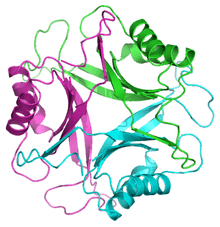Pii nitrogen regulatory proteins
| Nitrogen regulatory protein P-II | |||||||||
|---|---|---|---|---|---|---|---|---|---|
 | |||||||||
| Identifiers | |||||||||
| Symbol | P-II | ||||||||
| Pfam | PF00543 | ||||||||
| Pfam clan | CL0089 | ||||||||
| InterPro | IPR002187 | ||||||||
| SMART | SM00938 | ||||||||
| PROSITE | PDOC00439 | ||||||||
| SCOP | 1pil | ||||||||
| SUPERFAMILY | 1pil | ||||||||
| |||||||||
The Nitrogen regulatory protein P-II family contains a series of homologous prokaryotic signalling proteins which are involved in the regulation of nitrogen metabolism. The proteins are post translationally modified via addition of a uridylyl group by the enzyme Uridylyltransferase. The presence or absence of this group modulates the behaviour of the protein. In turn, uridylation is controlled by cellular levels of alpha=ketoglutarate and ATP.
PII proteins exist in trimers in vivo and bind ATP in a cleft between the subunits. There are two flexible loops call the B-loop and T-loop which are involved in regulation of the protein. The T-loop contains a conserved tyrosine which is the site of uridyl attachment.
Following nitrogen starvation, increased intra-cellular concentrations of ammonia cause the de-uridylylation of GlnK. This then binds directly to the ammonia channel AmtB to block ammonia conduction.[2][3]
References
- ↑ Carr, P. D.; Cheah, E.; Suffolk, P. M.; Vasudevan, S. G.; Dixon, N. E.; Ollis, D. L. (1996). "X-ray structure of the signal transduction protein from Escherichia coli at 1.9 Å". Acta Crystallographica Section D. 52 (Pt 1): 93–104. doi:10.1107/S0907444995007293. PMID 15299730.
- ↑ Durand, A.; Merrick, M. (2006). "In Vitro Analysis of the Escherichia coli AmtB-GlnK Complex Reveals a Stoichiometric Interaction and Sensitivity to ATP and 2-Oxoglutarate". Journal of Biological Chemistry. 281 (40): 29558–29567. doi:10.1074/jbc.M602477200. PMID 16864585.
- ↑ Conroy, M. J.; Durand, A.; Lupo, D.; Li, X. -D.; Bullough, P. A.; Winkler, F. K.; Merrick, M. (2007). "The crystal structure of the Escherichia coli AmtB–GlnK complex reveals how GlnK regulates the ammonia channel". Proceedings of the National Academy of Sciences. 104 (4): 1213–1218. doi:10.1073/pnas.0610348104. PMC 1783118
 . PMID 17220269.
. PMID 17220269.